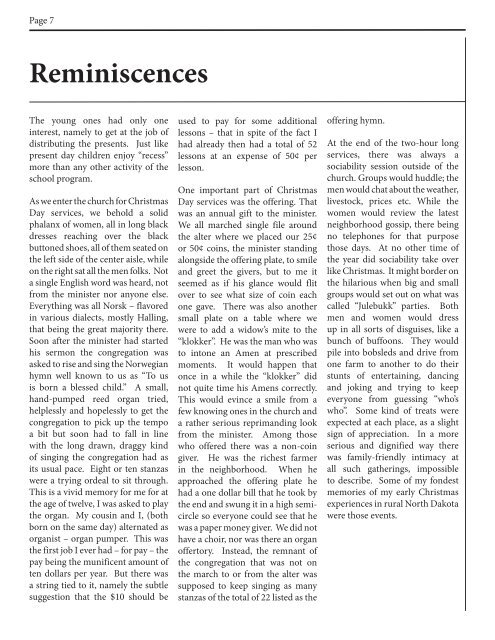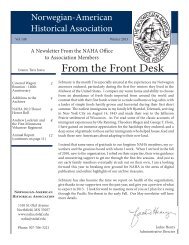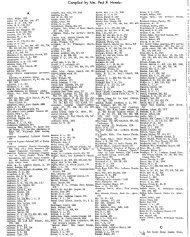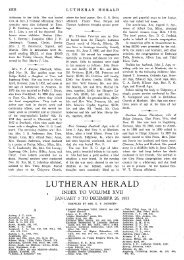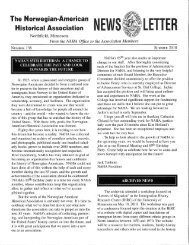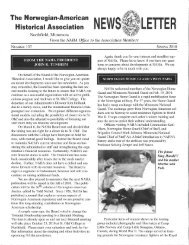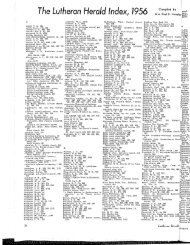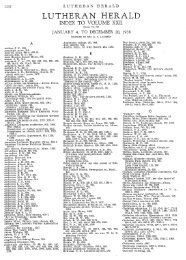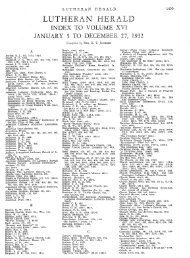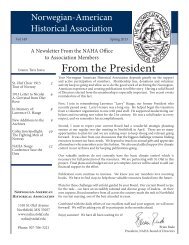Fall 2011 - Norwegian-American Historical Association - St. Olaf ...
Fall 2011 - Norwegian-American Historical Association - St. Olaf ...
Fall 2011 - Norwegian-American Historical Association - St. Olaf ...
You also want an ePaper? Increase the reach of your titles
YUMPU automatically turns print PDFs into web optimized ePapers that Google loves.
Page 7<br />
Reminiscences<br />
The young ones had only one<br />
interest, namely to get at the job of<br />
distributing the presents. Just like<br />
present day children enjoy “recess”<br />
more than any other activity of the<br />
school program.<br />
As we enter the church for Christmas<br />
Day services, we behold a solid<br />
phalanx of women, all in long black<br />
dresses reaching over the black<br />
buttoned shoes, all of them seated on<br />
the left side of the center aisle, while<br />
on the right sat all the men folks. Not<br />
a single English word was heard, not<br />
from the minister nor anyone else.<br />
Everything was all Norsk – flavored<br />
in various dialects, mostly Halling,<br />
that being the great majority there.<br />
Soon after the minister had started<br />
his sermon the congregation was<br />
asked to rise and sing the <strong>Norwegian</strong><br />
hymn well known to us as “To us<br />
is born a blessed child.” A small,<br />
hand-pumped reed organ tried,<br />
helplessly and hopelessly to get the<br />
congregation to pick up the tempo<br />
a bit but soon had to fall in line<br />
with the long drawn, draggy kind<br />
of singing the congregation had as<br />
its usual pace. Eight or ten stanzas<br />
were a trying ordeal to sit through.<br />
This is a vivid memory for me for at<br />
the age of twelve, I was asked to play<br />
the organ. My cousin and I, (both<br />
born on the same day) alternated as<br />
organist – organ pumper. This was<br />
the first job I ever had – for pay – the<br />
pay being the munificent amount of<br />
ten dollars per year. But there was<br />
a string tied to it, namely the subtle<br />
suggestion that the $10 should be<br />
used to pay for some additional<br />
lessons – that in spite of the fact I<br />
had already then had a total of 52<br />
lessons at an expense of 50¢ per<br />
lesson.<br />
One important part of Christmas<br />
Day services was the offering. That<br />
was an annual gift to the minister.<br />
We all marched single file around<br />
the alter where we placed our 25¢<br />
or 50¢ coins, the minister standing<br />
alongside the offering plate, to smile<br />
and greet the givers, but to me it<br />
seemed as if his glance would flit<br />
over to see what size of coin each<br />
one gave. There was also another<br />
small plate on a table where we<br />
were to add a widow’s mite to the<br />
“klokker”. He was the man who was<br />
to intone an Amen at prescribed<br />
moments. It would happen that<br />
once in a while the “klokker” did<br />
not quite time his Amens correctly.<br />
This would evince a smile from a<br />
few knowing ones in the church and<br />
a rather serious reprimanding look<br />
from the minister. Among those<br />
who offered there was a non-coin<br />
giver. He was the richest farmer<br />
in the neighborhood. When he<br />
approached the offering plate he<br />
had a one dollar bill that he took by<br />
the end and swung it in a high semicircle<br />
so everyone could see that he<br />
was a paper money giver. We did not<br />
have a choir, nor was there an organ<br />
offertory. Instead, the remnant of<br />
the congregation that was not on<br />
the march to or from the alter was<br />
supposed to keep singing as many<br />
stanzas of the total of 22 listed as the<br />
offering hymn.<br />
At the end of the two-hour long<br />
services, there was always a<br />
sociability session outside of the<br />
church. Groups would huddle; the<br />
men would chat about the weather,<br />
livestock, prices etc. While the<br />
women would review the latest<br />
neighborhood gossip, there being<br />
no telephones for that purpose<br />
those days. At no other time of<br />
the year did sociability take over<br />
like Christmas. It might border on<br />
the hilarious when big and small<br />
groups would set out on what was<br />
called “Julebukk” parties. Both<br />
men and women would dress<br />
up in all sorts of disguises, like a<br />
bunch of buffoons. They would<br />
pile into bobsleds and drive from<br />
one farm to another to do their<br />
stunts of entertaining, dancing<br />
and joking and trying to keep<br />
everyone from guessing “who’s<br />
who”. Some kind of treats were<br />
expected at each place, as a slight<br />
sign of appreciation. In a more<br />
serious and dignified way there<br />
was family-friendly intimacy at<br />
all such gatherings, impossible<br />
to describe. Some of my fondest<br />
memories of my early Christmas<br />
experiences in rural North Dakota<br />
were those events.


